BUFFALO 04600022-0 Wireless LAN 802.11g USB2.0 Adapter User Manual USB KEychainManual indd
BUFFALO INC. Wireless LAN 802.11g USB2.0 Adapter USB KEychainManual indd
BUFFALO >
Contents
- 1. Users Manual Part 1
- 2. Users Manual Part 2
- 3. Manual
Users Manual Part 2
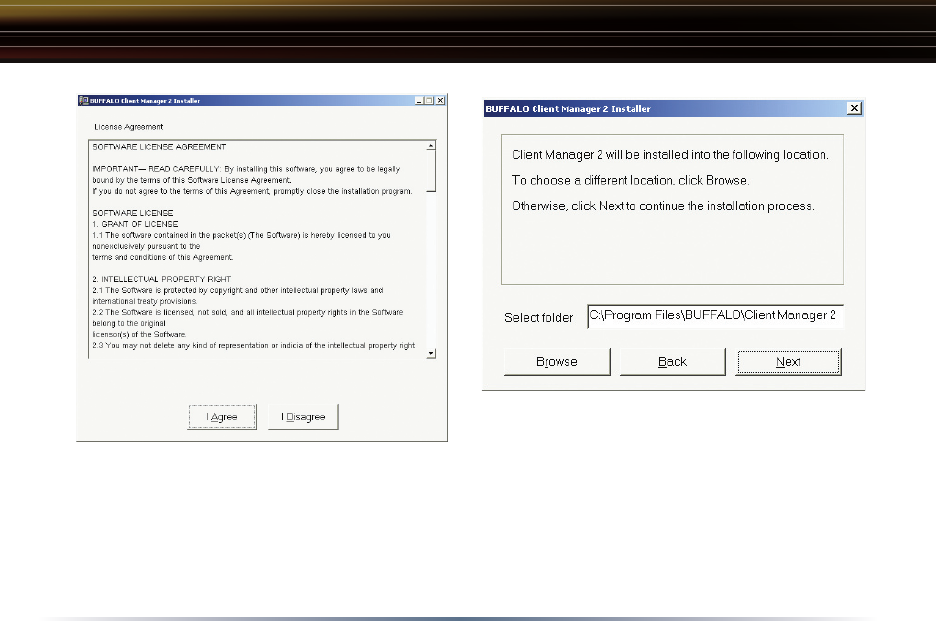
13
Client Manager
◗ Once the Installer Wizard launches, click the Next button to begin the
software installation.
◗ Press I Agree to accept the license agreement and continue the installation
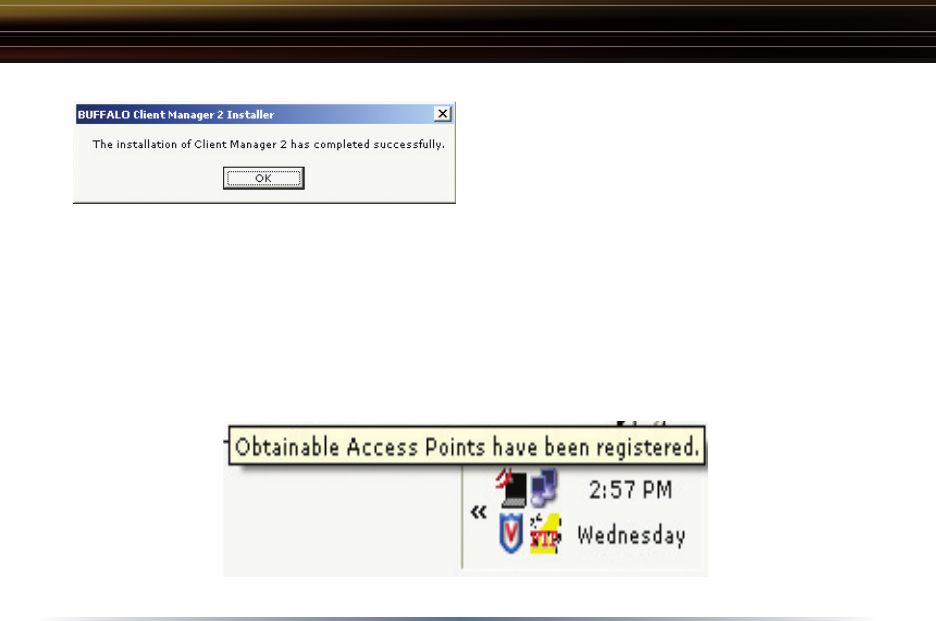
14
Client Manager
◗ Press the OK button to finish and
close the installation program.
◗ Press the Exit button to exit the Client Manager installation utility.
◗ The Buffalo Client Manager is now installed and running, right clicking on its
icon (the black notebook icon) will allow you to begin using it.
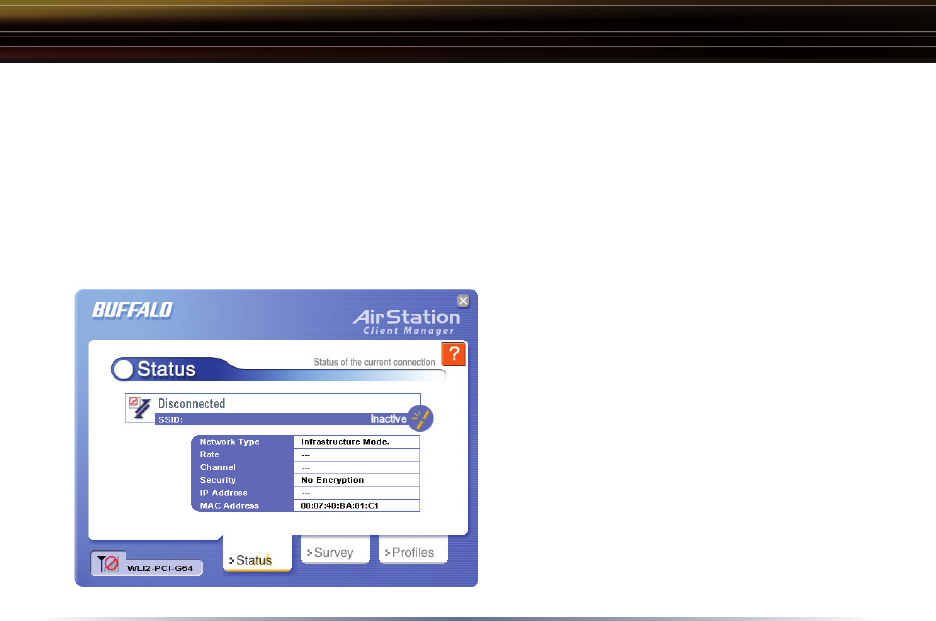
15
Client Manager Configuration
Use Client Manager to configure your wireless network. To assist in configuring
your wireless network, Client Manager consists of the Status page, the Survey
page, and the Profiles page. You can access each page by clicking the corre-
sponding button on Client Manager. In addition to these pages, several dialog
boxes are available to meet specialized configuration needs. You can access
the Edit Profile dialog box, New Profile dialog box, IP Configuration dialog box,
or WEP Configuration dialog box using the Client Manager pages.
Status Page
Click the Status button to open this
page. By default, this page is dis-
played when you start
Client Manager. This page displays
the status of the connection be-
tween the wireless adapter and
another wireless device. This page
only displays connection information
no changes to the connection can be
made from this screen.
This page includes the following
components:
Client Manager Configuration

16
Client Manager Configuration
• Rate – The speed that the two wireless clients are communicating at. If the
Client Manager is not connected to a remote wireless device (access point or
another client) then no rate will be displayed.
• Channel – The channel that the two wireless clients are communicating at.
If the Client Manager is not connected to a remote wireless device (access
point of another client) then no channel will be displayed. The available chan-
nels for use are 1-11.
• Security– The type of encryption that the two wireless clients are communicat-
ing with. If the Client Manager is not connected to a remote wireless device
(access point of another client) then ‘No Encryption’ will be displayed.
• IP Address – The IP address of the machine the Client Manager is installed on.
If the Client Manager is not connected to a remote wireless device (access
point of another client) or is not connected to a network with DHCP, then no
IP address will be displayed.
• MAC Address – The MAC address of the wireless client device inside the com-
puter Client Manager is installed on. If no wireless device is present in the
computer, then no MAC Address will be displayed.
• Signal Strength – Displays the strength of the signal. Signal Strength is based
on the peak signal level the wireless adapter receives from the wireless device
to which it is connected. Next to the signal level is the wireless hardware type
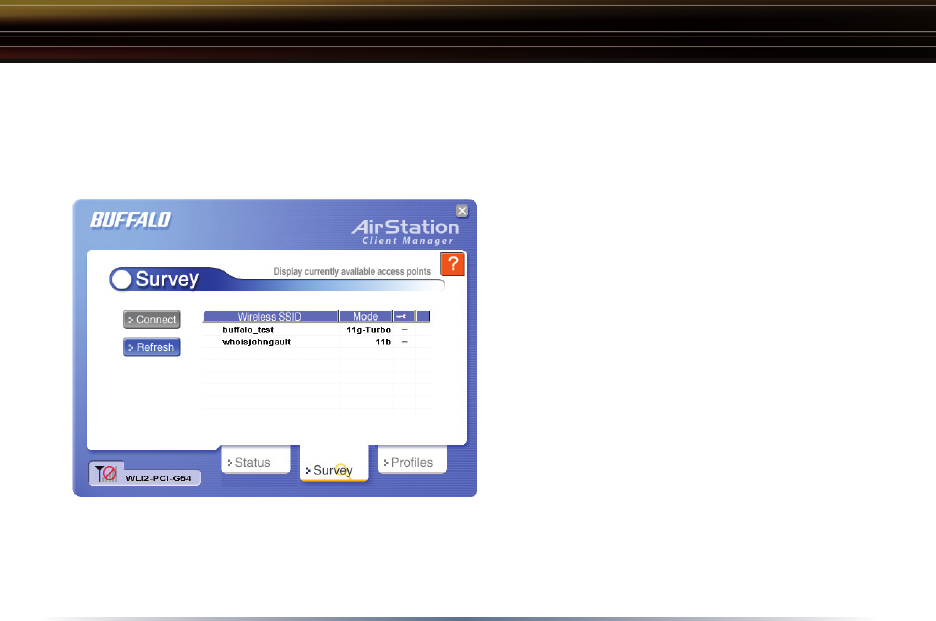
17
Client Manager Configuration
Survey Page
Click the Survey button to open this page. Use this page to survey the area, dis-
play available access points, and connect to available access points.
This page includes the following
components:
• Wireless SSID – Displays the SSID as-
sociated with each available access
point. The SSID is the unique net-
work name that functions as an iden-
tifier for your wireless devices. All
wireless devices on a network must
use identical SSIDs to successfully
associate with other devices on the
network. buffalo_test is an example
of a valid SSID.
• Mode – Displays the mode/rate set
that the remote wireless device is
offering.
• Key – Displays whether the wireless network is using any sort of encryption.
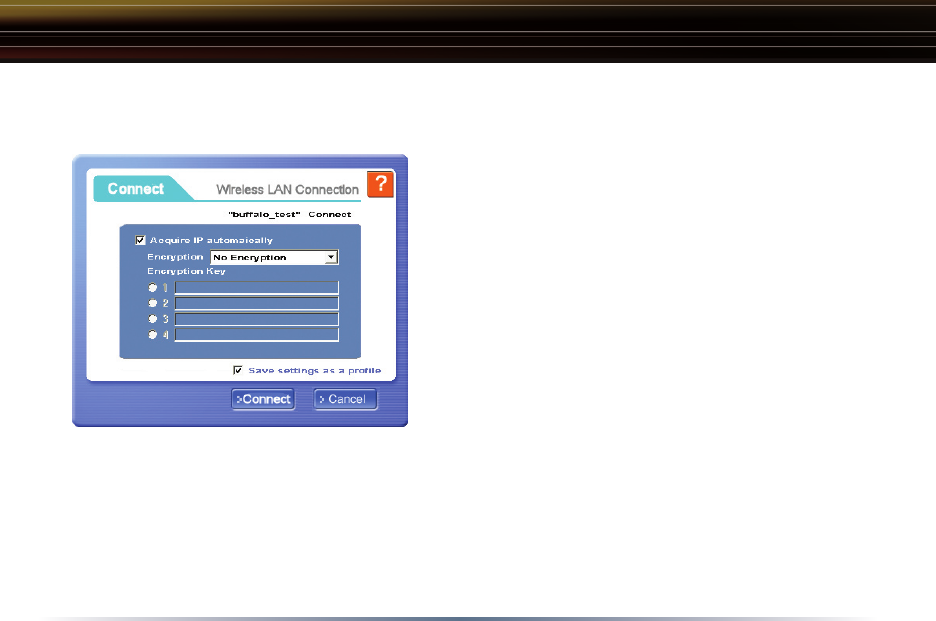
18
Client Manager Configuration
Once the ‘Connect’ button is pressed, you will be prompted to enter any encryp-
tion related information.
The ‘Acquire IP automatically’ checkbox tells
the client device to obtain an IP automati-
cally from a DHCP server. This is the rec-
ommended setting.
The ‘Encryption’ drop down list allows you to
select the type of encryption for the net-
work. By default the proper encryption type
should already be selected. In the event
that no encryption is used, leave the ‘No
Encryption’ option selected.
by the wireless network must be inputted. Please consult your wireless access
point or router’s documentation for proper input of the encryption keys. Some
wireless networks may require you to enter multiple keys, in this event, four
separate fields are available for encryption keys.
The ‘Save settings as a profile’ option will store this wireless network in your pro-
files. This means you will automatically connect to this network when inside
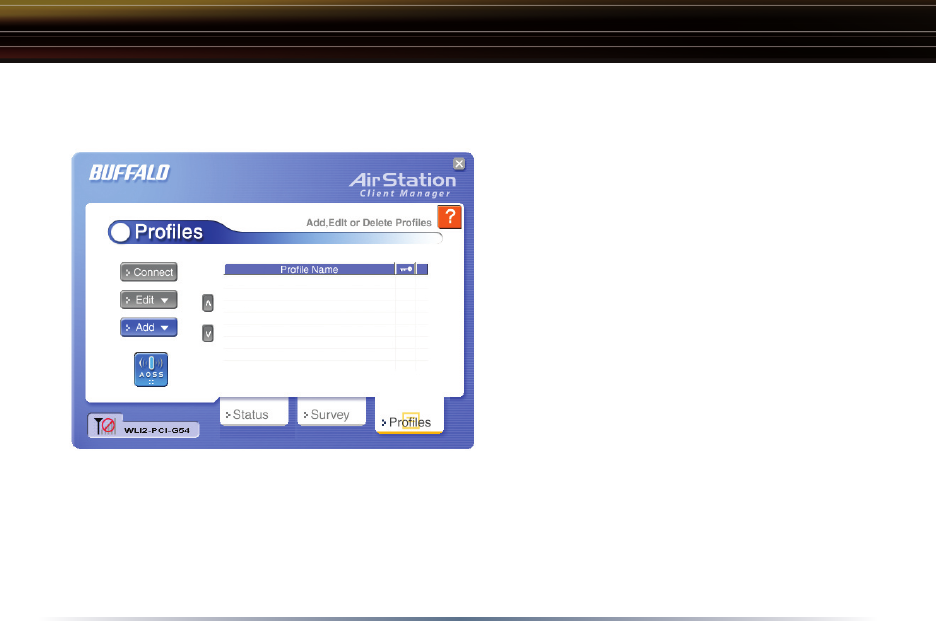
19
Profiles Page
Click the Profiles button to open this
page. Use this page to access your
profiles. Profiles allow you to save
the information associated with a
specific wireless network so you can
quickly and easily connect to that
network when you are in that loca-
tion. The Profiles page allows you to
add, delete, and edit your profiles, as
well as import and export data.
• Connect – Click the Connect button to
connect to the selected profile and
return to the ‘Status’ page.
• Edit – Click the Edit button to edit the selected profile’s settings. The Edit but-
ton also allows you to delete a profile no longer used or required.
• Add – Click the Add button to add a profile manually. You will need important
information such as SSID, encryption settings, and network type.
Client Manager Configuration
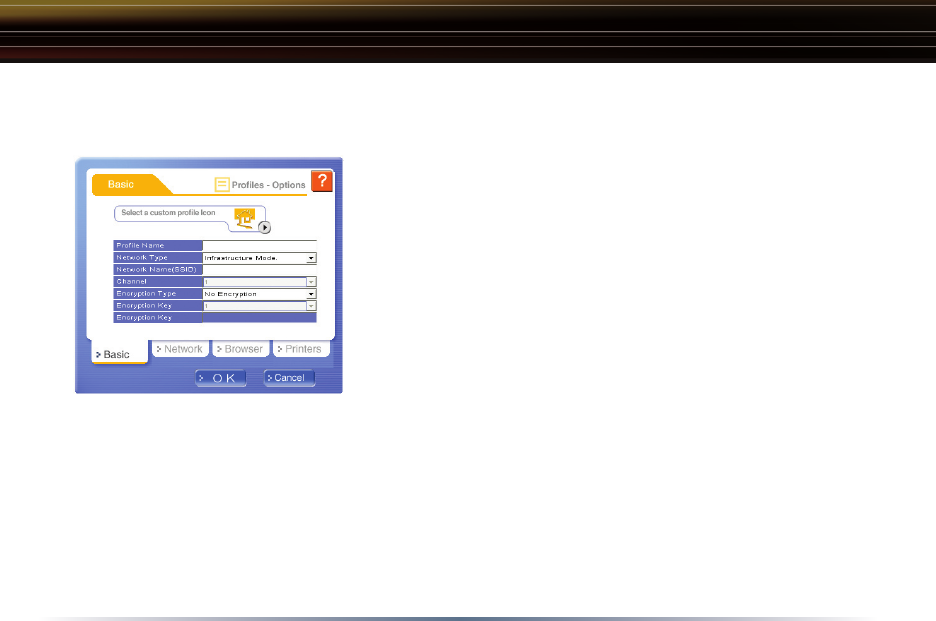
20
New Profile Dialog Box
Use this dialog box to create a new profile.
Client Manager Configuration
• Profile Name – Enter the name you want to associ-
ate with the new profile.
• Network Type – Select the network mode you want
to associate with the new profile. Select Infra-
structure if your network consists of both wired
and wireless devices that communicate through
a central device, such as an access point. Select
Ad-hoc if your network consists of only wire-
less devices that communicate with each other
directly.
• Network Name SSID – Enter the SSID of your net-
must use identical SSIDs to successfully associate with other devices on the
network. myssid is an example of a valid SSID.
• Channel – Displays the channel associated with the new profile. The channel
indicates what range of frequencies the radio waves emitted by the wireless
device are occupying. Devices that meet 802.11b and 802.11g standards can
use channels 1-11 within the 2.4 GHz spectrum.
• Encryption Type – Displays the types of encryptions available. Once selected,
you will be required to enter the Encryption Key Number and the Encryption Key
as well. For the Encryption Key Number, it is recommended to use 1 unless
specified to by an administrator.

21
Client Manager Configuration
Advanced Profile Options
• Network Tab – Displays the network information tab. A static IP can be speci-
fied for this wireless profile here. It is not recommended to change any of
these settings unless specified by an administrator.
• Browser Tab – Displays settings to change your browser preferences for this
wireless profile. A specific home page can be specified when connected to
this wireless profile as can specific proxy server addresses.
• Printers Tab – Displays the printers tab. A specific default printer can be asso-
ciated to this profile. Thus, when connected to this profile, a specific printer
will be used as the default printer.
• Network Tab – Displays the network information tab. A static IP can be speci-
fied for this wireless profile here. It is not recommended to change any of
these settings unless specified by an administrator.
• AOSS Icon – The AOSS icon is used to launch AOSS client requests
for AOSS communication. Inside your wireless client’s box, an
AOSS supplement guide is present. This guide leads to step-by-

22
Placeholder

23
Wireless Zero Configuration
Wireless Zero Configuration Service (Windows XP)
Windows XP offers the Wireless Zero Configuration Service to support 802.11b
and 802.11g wireless networking. This service automatically polls the area for
available wireless access points. If an available wireless access point is found,
Windows attempts to connect to the access point. If no available wireless ac-
cess points are found, you must manually add the access points.
■ Note: The Wireless Zero Configuration Service and Client Manager do not
function properly together. If you want to use Client Manager, you must disable
the Wireless Zero Configuration Service.
Enabling the Wireless Zero Configuration Service
Select Start»Control Panel»Administrative Tools»Services to open the Services win-
dow. Select Automatic in the Startup Type field of Wireless Zero Configuration
Service to enable the Wireless Zero Configuration Service.
■ Note: The default Startup Type value of Wireless Zero Configuration Service
is Automatic.
Disabling the Wireless Zero Configuration Service
Select Start»Control Panel»Administrative Tools»Services to open the Services win-
dow. Select Disabled in the Startup Type field of Wireless Zero Configuration
Service to disable the Wireless Zero Configuration Service.

24
Placeholder

25
Specifications
Communication Range
Speed Indoor Outdoor
54Mbps 165 ft. (50m) 525 ft. (160m)
11Mbps 300 ft. (90m) 1310 ft. (400m)
1Mbps 375 ft. (115m) 1750 ft. (550m)
All distances are estimated. Wireless connections may be affected as physical conditions and
circumstances vary.

26
Troubleshooting / FAQ
Troubleshooting / FAQ
Use this section to locate answers to frequently asked questions.
What should I do if I already have a version of Client Manager on my PC?
Update your Client Manager to the version on the CD. If you do not update
your Client Manager, there could be a loss of functionally, as some versions of
Client Manager will not work properly with the G54 Wireless 54Mbps Desktop
PCI Adapter. Before updating Client Manager, you must uninstall all previous
versions of Client Manager. To update your Client Manager, load the Air
Navigator CD and select Install Client Manager.
Why won't all my network clients work?
Some operating systems support only a limited number of network clients.
Windows 98/Me: These operating systems support only four network clients. If
you install more than four network clients, only the first four clients you install
will work.
Will Client Manager support all operating systems?
Client Manager and the G54 Wireless 54Mbps Desktop PCI Adapter currently
support only Windows 98/ME/2000/XP. They do not currently support Windows
NT, Mac OS, or Linux. For more information, refer to the Mac OS and Linux page

27
Troubleshooting / FAQ
Why won't Client Manager function properly?
Windows XP – The Wireless Zero Configuration Service conflicts with Client Man-
ager. Select Start»Control Panel»Administrative Tools»Services to open the Services
window. Select Disabled in the Startup Type field of Wireless Zero Configuration
Service to disable the Wireless Zero Configuration Service.
I have more than one Air Navigator CD. Do I need more than one CD?
No. You receive the same Air Navagator CD with each Buffalo Technology ac-
cess point and wireless adapter. The CDs are identical and you only need one
copy.

28
10BaseT or 100BaseTx: 802.3 based
Ethernet network that uses UTP (Un-
shielded twisted pair) cable and a star
topology. 10 is 10 Mbps and 100 is
100 Mbps.
802.1x: The standard for wireless LAN
authentication used between an AP
and a client. 802.1x with EAP will ini-
tiate key handling.
Ad-Hoc Network: The wireless network
based on a peer-to-peer communica-
tions session. Also referred to as
AdHoc.
Bandwidth: The transmission capac-
ity of a computer or a communication
channel, stated in Megabits per sec-
ond (Mbps).
BSS (Basic Service Set): An 802.11 net-
working framework that includes an
Access Point.
Bus Mastering: A system in which the
specified Input/Output device (e.g. NIC
Card) can perform tasks without the
intervention of the CPU.
Client: A PC or workstation on a net-
work.
Cross-Over Wiring: A UTP cable that has
its transmit and receive pair crossed
to allow communications between two
devices.
DCE (Data Communications Equipment):
Hardware used for communication
with a Data Terminal Equipment (DTE)
device.
Default Gateway: The IP Address of
either the nearest router or server for
the LAN.
Default Parameter: Parameter set by the
manufacturer.
Destination Address: The address por-
tion of a packet that identifies the
intended recipient station.
Glossary

29
DHCP (Dynamic Host Configuration Proto-
col): Based on BOOTP, it uses a pool of
IP addresses, which it assigns to each
device connected to it, and retrieves
the address when the device becomes
dormant for a period of time.
DNS (Domain Name System): System
used to map readable machine names
into IP addresses
Driver: Software that interfaces a com-
puter with a specific hardware device.
DSSS (Direct Sequence Spread Spectrum):
Method of spreading a wireless signal
into wide frequency bandwidth.
DTE (Data Terminal Equipment): Device
that con10BaseT or 100BaseTx: 802.3
based Ethernet network that uses UTP
(Unshielded twisted pair) cable and a
star topology. 10 is 10 Mbps and 100
is 100 Mbps.
802.1x: The standard for wireless LAN
authentication used between an AP
and a client. 802.1x with EAP will ini-
tiate key handling.
Ad-Hoc Network: The wireless network
based on a peer-to-peer communica-
tions session. Also referred to as
AdHoc.
Bandwidth: The transmission capac-
ity of a computer or a communication
channel, stated in Megabits per sec-
ond (Mbps).
BSS (Basic Service Set): An 802.11 net-
working framework that includes an
Access Point.
Bus Mastering: A system in which the
specified Input/Output device (e.g. NIC
Card) can perform tasks without the
intervention of the CPU.
Client: A PC or workstation on a net-
work.
Cross-Over Wiring: A UTP cable that has
Glossary

30
its transmit and receive pair crossed
to allow communications between two
devices.
DCE (Data Communications Equipment):
Hardware used for communication
with a Data Terminal Equipment (DTE)
device.
Default Gateway: The IP Address of
either the nearest router or server for
the LAN.
Default Parameter: Parameter set by the
manufacturer.
Destination Address: The address portion
of a packet that identifies the intended
recipient station.
DHCP (Dynamic Host Configuration Proto-
col): Based on BOOTP, it uses a pool of
IP addresses, which it assigns to each
device connected to it, and retrieves
the address when the device becomes
dormant for a period of time.
DNS (Domain Name System): System
used to map readable machine names
into IP addresses
Driver: Software that interfaces a com-
puter with a specific hardware device.
DSSS (Direct Sequence Spread Spectrum):
Method of spreading a wireless signal
into wide frequency bandwidth.
DTE (Data Terminal Equipment): Device
that controls data flowing to and from
a computer.
Dynamic IP Address: An IP address that
is automatically assigned to a client
station in a TCP/IP network, typically
by a DHCP server.
ESS (Extended Service Set): A set of two
or more BSSs that form a single sub-
network. ESS-ID is user identification
used in the ESS LAN configuration.
Ethernet: The most widely used ar-
Glossary

31
bits per second.
Half-duplex: To transmit on the same
channel in both directions, one direc-
tion at a time.
Hub: A device which allows connec-
tion of computers and other devices to
form a LAN.
IEEE (Institute of Electrical and Electronics
Engineers): The professional organiza-
tion which promotes development of
electronics technology.
IP (Internet Protocol) Address: A unique
32-binary-digit number that identifies
each sender or receiver of information
sent in packets.
Infrastructure: A wireless network or
other small network in which the wire-
less network devices are made a part
of the network through the Access
Point.
chitecture for Local Area Networks
(LANs). It is a shared-media network
architecture. The IEEE 802.3 standard
details its functionality.
Ethernet cable: A wire similar to tele-
phone cable that carries signals be-
tween Ethernet devices.
File and Print Sharing: A Microsoft ap-
plication that allows computers on a
network to share files and printers.
Firmware: Programming inserted into
programmable read-only memory, thus
becoming a permanent part of a com-
puting device.
Frame: A fixed block of data, transmit-
ted as a single entity. Also referred to
as packet.
Full-Duplex: To transmit on the same
channel in both directions simultane-
ously.
Gbps (Giga Bits per second): One billion
Glossary

32
ISP (Internet Service Provider): A company
that provides access to the Internet
and other related services.
IV (Initialization Vector): The header sec-
tion of a message packet.
LAN (Local Area Network): A group of
computers and peripheral devices con-
nected to share resources.
LED (Light Emitting Diode): The lights on
a hardware device representing the
activity through the ports.
MAC (Medium Access Control) Address: A
unique number that distinguishes net-
work cards.
Mbps (Mega Bits Per Second): A measure-
ment of millions of bits per second.
MDI/X (Media Dependent Interface/Cross-
over): Port on a network hub or switch
that crosses the incoming transmit
lines with the outgoing receive lines.
MHz (MegaHertz): One million cycles per
second.
MIB II: A database containing perfor-
mance information and statistics on
each device in a network.
MIPS (Million Instructions Per Second): A
measurement of processing speed.
NAT (Network Address Translation): An
internet standard that enables a LAN
to use one set of IP addresses for
internal traffic and a second set for
external traffic.
NIC (Network Interface Card): An expan-
sion card connected to a computer so
the computer can be connected to a
network.
Packet: A block of data that is trans-
ferred as a single unit, also called a
frame or a block.
Packet Filtering: Discarding unwanted
Glossary

33
network traffic based on its originating
address or its type.
PCI (Peripheral Component Interconnect): A
bus that is connected directly to the
CPU.
PCMCIA (Personal Computer Memory Card
International Association) Card: Remov-
able module that adds features to a
portable computer.
Ping (Packet Internet Groper): An Internet
utility used to determine whether a
particular IP address is online.
Plug and Play: Hardware that, once
installed (“plugged in”), can immedi-
ately be used (“played”), as opposed
to hardware that requires manual
configuration.
PoE (Power over Ethernet): A mechanism
to send DC power to a device using a
CAT5 Ethernet cable.
PPPoE (Point-to-Point Protocol over Eth-
ernet): A specification for connect-
ing users on an Ethernet line to the
Internet through a common broadband
medium.
Protocol: A standard way of exchang-
ing information between computers.
RADIUS (Remote Authentication Dial In User
Service): A server that issues authenti-
cation key to clients.
RAM (Random Access Memory): Non-per-
manent memory.
Repeater Hub: A device that collects,
strengthens and transmits information
to all connected devices, allowing the
network to be extended to accommo-
date additional workstations.
RC4: The encryption algorithm that is
used in WEP.
RJ-45 connector: An 8-pin connector
used between a twisted pair cable and
Glossary

34
a data transmission device.
ROM (Read Only Memory): Permanent
memory.
Router: Device that can connect in-
dividual LANs and remote sites to a
server.
Roaming: The ability to use a wireless
device while moving from one access
point to another without losing the
connection.
Script: A macro or batch file contain-
ing instructions and used by a com-
puter to perform a task.
Server: Any computer that makes files
or peripheral devices available to us-
ers of the network and has a resident
Network OS.
SMTP (Simple Mail Transfer Protocol): The
protocol used to define and deliver
electronic mail (E-mail) from one loca-
tion to another.
SNMP (Simple Network Management Proto-
col: An application layer protocol that
outlines the formal structure for com-
munication among network devices.
Static IP Address: A permanent IP ad-
dress is assigned to a node in a TCP/IP
network. Also known as global IP.
STP (Shielded Twisted Pair): Twisted Pair
cable wrapped in a metal sheath to
provide extra protection from external
interfering signals.
Subnet Mask: An eight-byte address
divided into 4 parts separated by peri-
ods.
TCP/IP (Transmission Control Protocol/Inter-
net Protocol: Protocol used by comput-
ers when communicating across the
Internet or Intranet.
TFTP (Trivial File Transfer Protocol): Sim-
Glossary

35
ple form of FTP (File Transfer Protocol), which Uses UDP (User Datagram Protocol),
rather than TCP/IP for data transport and provides no security features.
TKIP (Temporal Key Integrity Protocol): An encryption method replacing WEP. TKIP
uses random IV and frequent key exchanges.
Topology: The shape of a LAN (Local Area Network) or other communications sys-
tem.
Twisted Pair: Cable that comprises 2 or more pair of insulated wires twisted togeth-
er.
UDP (User Datagram Protocol): A communication method (protocol) that offers a
limited amount of service when messages are exchanged between computers in a
network. UDP is used as an alternative to TCP/IP.
Uplink: Link to the next level up in a communication hierarchy.
UTP (Unshielded Twisted Pair) cable: Two or more unshielded wires twisted together to
form a cable.
WAN (Wide Area Network): A networking system covering a wide geographical area.
WEP (Wired Equivalent Privacy): An encryption method based on 64 or 128-bit algo-
rithm.
Web Browser: A software program that allows viewing of web pages.
Wi-Fi (Wireless Fidelity): An organization that tests and assures interoperability
FCC / CE Information

36
Placeholder

37
FCC / CE Information

38
Warranty Information
Buffalo Technology (USA), Inc. products comes with a two-year limited warranty
from the date of purchase. Buffalo Technology (USA), Inc. warrants to the original
purchaser the product; good operating condition for the warranty period. This war-
ranty does not include non-Buffalo Technology (USA), Inc. installed components.
If the Buffalo product malfunctions during the warranty period, Buffalo Technol-
ogy (USA) Inc. will, replace the unit, provided the unit has not been subjected
to misuse, abuse, or non-Buffalo Technology (USA), Inc. authorized alteration,
modifications or repair.
All expressed and implied warranties for the Buffalo Technology (USA) Inc. product
line including, but not limited to, the warranties of merchantability and fitness of
a particular purpose are limited in duration to the above period.
Under no circumstances shall Buffalo Technology (USA), Inc. be liable in any way
to the user for damages, including any lost profits, lost savings or other incidental
or consequential damages arising out of the use of, or inability to use the Buffalo
products.
In no event shall Buffalo Technology (USA), Inc. liability exceed the price paid for
the product from direct, indirect, special, incidental, or consequential damages
resulting from the use of the product, its accompanying software, or its documen-

39
Contact Information
ADDRESS
Buffalo Technology (USA), Inc.
4030 West Braker Lane, Suite 120
Austin, TX 78759-5319
GENERAL INQUIRIES
Monday through Friday
8:30am-5:30pm CST
Direct: 512-794-8533
Toll-free: 800-456-9799
Fax: 512-794-8520
Email: sales@buffalotech.com
TECHNICAL SUPPORT
North American Technical Support by phone is available 24 hours a day, 7
days a week. (USA and Canada).
Toll-free: (866) 752-6210
Email: info@buffalotech.com

40
Technical Support is available 24 hours a day, 7 days a week
(USA / Canada)
Toll-Free: 866-752-6210
email: info@buffalotech.com
©2004, Buffalo Technology (USA), Inc.
4030 W. Braker Ln. Suite
120
Austin, Texas 78759
Tel: 800-456-9799
Federal Communication Commission Interference Statement
This equipment has been tested and found to comply with the limits for a Class B digital
device, pursuant to Part 15 of the FCC Rules. These limits are designed to provide
reasonable protection against harmful interference in a residential installation. This
equipment generates, uses and can radiate radio frequency energy and, if not installed
and used in accordance with the instructions, may cause harmful interference to radio
communications. However, there is no guarantee that interference will not occur in a
particular installation. If this equipment does cause harmful interference to radio or
television reception, which can be determined by turning the equipment off and on, the
user is encouraged to try to correct the interference by one of the following measures:
- Reorient or relocate the receiving antenna.
- Increase the separation between the equipment and receiver.
- Connect the equipment into an outlet on a circuit different from that
to which the receiver is connected.
- Consult the dealer or an experienced radio/TV technician for help.
FCC Caution: Any changes or modifications not expressly approved by the party
responsible for compliance could void the user's authority to operate this equipment.
This device complies with Part 15 of the FCC Rules. Operation is subject to the following
two conditions: (1) This device may not cause harmful interference, and (2) this device
must accept any interference received, including interference that may cause undesired
operation.
IMPORTANT NOTE:
FCC Radiation Exposure Statement:
This equipment complies with FCC radiation exposure limits set forth for an uncontrolled
environment.
This device complies with FCC RF Exposure limits set forth for an uncontrolled
environment, under 47 CFR 2.1093 paragraph (d)(2).
This transmitter must not be co-located or operating in conjunction with any other antenna
or transmitter.
This equipment has been SAR-evaluated for use in laptops (notebooks) with rear
configuration.
Highest SAR value: 0.586W/kg